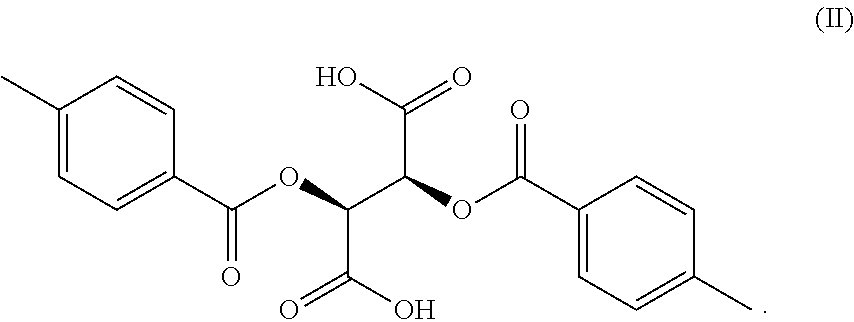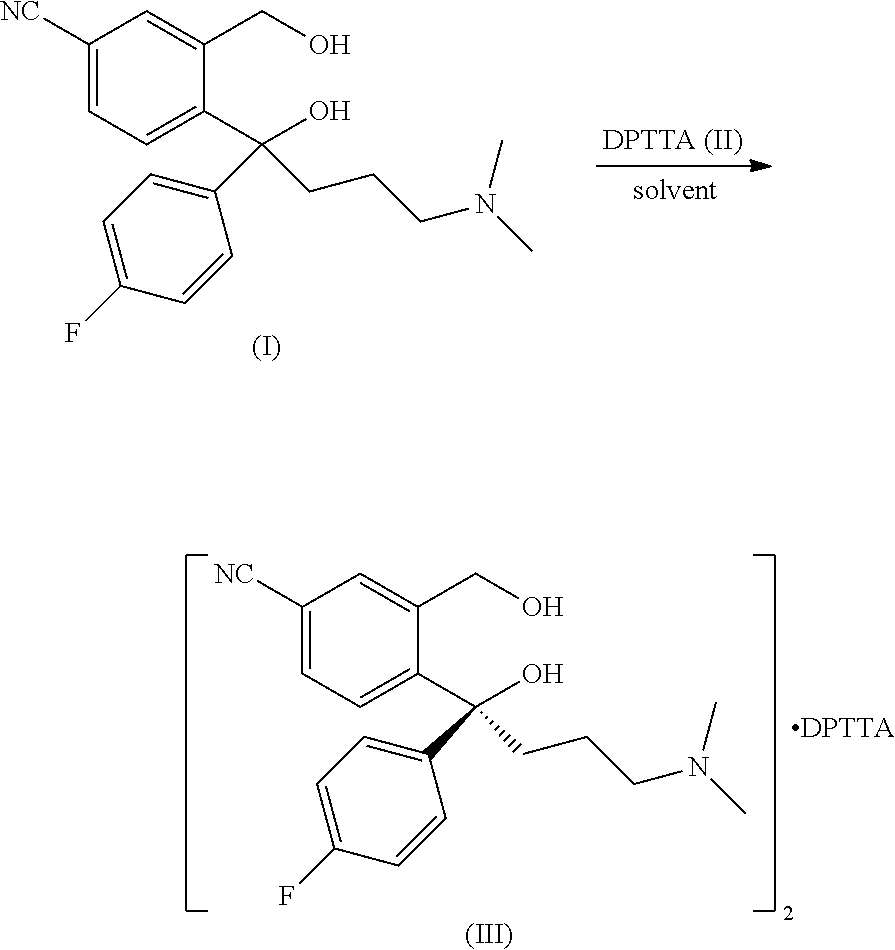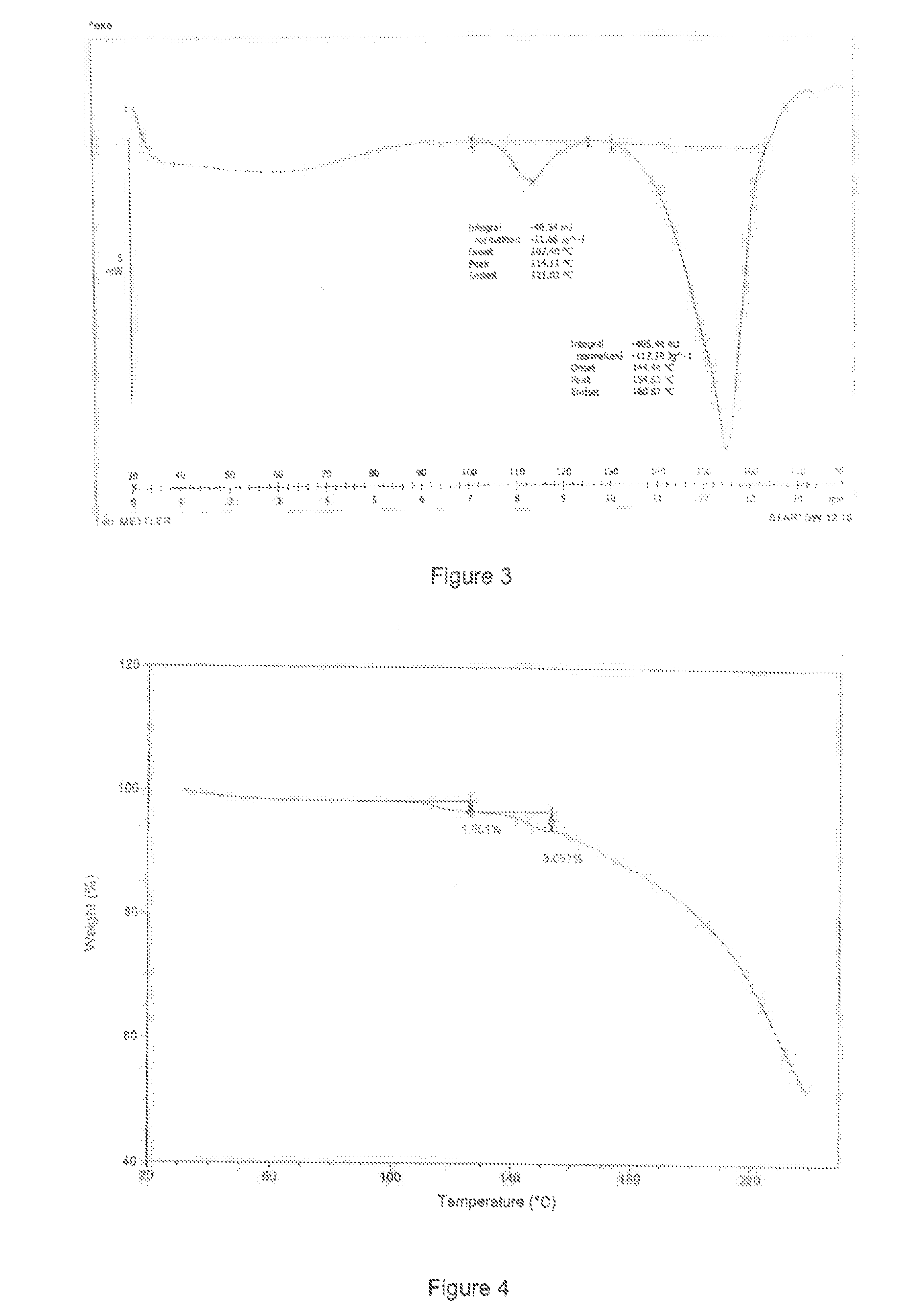Method For Resolution Of Citalopram Intermediate 5-cyano Diol
LIANG; Zunjun ; et al.
U.S. patent application number 16/282922 was filed with the patent office on 2019-06-20 for method for resolution of citalopram intermediate 5-cyano diol. The applicant listed for this patent is ZHEJIANG HUAHAI PHARMACEUTICALS CO., LTD.. Invention is credited to Siqi Hu, Wenfeng HUANG, Zunjun LIANG, Qifeng LU, Caihua PENG, Guoliang TU.
| Application Number | 20190185418 16/282922 |
| Document ID | / |
| Family ID | 55953616 |
| Filed Date | 2019-06-20 |












View All Diagrams
| United States Patent Application | 20190185418 |
| Kind Code | A1 |
| LIANG; Zunjun ; et al. | June 20, 2019 |
METHOD FOR RESOLUTION OF CITALOPRAM INTERMEDIATE 5-CYANO DIOL
Abstract
Provided is a method for resolution of formula 4-[4-dimethylamino-1-(4-fluorophenyl)-1-hydroxylbutyl]-3-hydroxy-methyl benzonitrile as an enantiomer thereof, comprising the following steps: a salt of (S)-4-[4-dimethylamino-1-(4-fluorophenyl)-1-hydroxylbutyl]-3-hydr- oxymethyl benzonitrile with a resolving agent D-(+)di-p-toluoyl tartaric acid was crystallized in a resolving solvent; the method is characterized in that the resolving solvent is an ether solvent. Also provided is a new crystal form of the resolved intermediate.
| Inventors: | LIANG; Zunjun; (Zhejlang, CN) ; Hu; Siqi; (Zhejlang, CN) ; PENG; Caihua; (Zhejlang, CN) ; HUANG; Wenfeng; (Zhejlang, CN) ; LU; Qifeng; (Zhejlang, CN) ; TU; Guoliang; (Zhejlang, CN) | ||||||||||
| Applicant: |
|
||||||||||
|---|---|---|---|---|---|---|---|---|---|---|---|
| Family ID: | 55953616 | ||||||||||
| Appl. No.: | 16/282922 | ||||||||||
| Filed: | February 22, 2019 |
Related U.S. Patent Documents
| Application Number | Filing Date | Patent Number | ||
|---|---|---|---|---|
| 15521776 | Apr 25, 2017 | |||
| PCT/CN2014/091139 | Nov 14, 2014 | |||
| 16282922 | ||||
| Current U.S. Class: | 1/1 |
| Current CPC Class: | C07B 2200/13 20130101; C07C 255/50 20130101; C07C 253/34 20130101; C07C 69/78 20130101; C07C 255/59 20130101 |
| International Class: | C07C 253/34 20060101 C07C253/34; C07C 69/78 20060101 C07C069/78; C07C 255/59 20060101 C07C255/59 |
Claims
1-4. (canceled)
5. A crystal form of the resolved intermediate of formula III, ##STR00008## characterized in that the DSC thermogram obtained from differential scanning calorimetry (heating rate 10.degree. C./minute) shows an endothermic peak, which is onset 135.20.degree. C., peak 150.85.degree. C.
6. A crystal form of the resolved intermediate of formula III', ##STR00009## characterized in that the DSC thermogram obtained from differential scanning calorimetry (heating rate 10.degree. C./minute) shows two endothermic peaks, which are onset 107.40.degree. C., peak 114.11.degree. C., and onset 144.44.degree. C., peak 154.55.degree. C. respectively.
7. The crystal form according to claim 6, characterized in that the thermogravimetric analysis thermogram is shown in FIG. 4.
8. The crystal form according to claim 6, characterized in that the powder X-ray diffraction pattern is shown in FIG. 5.
Description
TECHNICAL FIELD
[0001] The present invention relates to a method for resolution of citalopram intermediate 5-cyano diol.
TECHNICAL BACKGROUND
[0002] Citalopram is an important anti-depression drug, which is a selective 5-hydroxytryptamine (5-HT) reuptake inhibitor with S-configuration, and the isomer with S-citalopram has an anti-depression effect that is 100 times more than the isomer of the opposite configuration--R-citalopram, therefore, it has a much better curative effect and much less dosage. In the market of Europe and America, the S-isomer is mainly sold, and it is prepared by the cyclization and salt-forming reaction of S-5-cyano diol (IV).
[0003] S-5-cyano diol (IV) is the key initial raw material for producing S-citalopram, in industrial production, generally, it is prepared by forming a salt from racemic 5-cyano diol (I) and a resolving agent D-(+)di-p-toluoyl tartaric acid (II) (abbr. DPTTA) in alcohols and mixed solvents comprising alcohols, separating the (S)-5-cyano diol resolved intermediate (Ill) by crystallization, then subjecting to ionization by a free base. The resolution process can be represented as follows:
##STR00001##
[0004] The structure of the resolving agent DPTTA is as follows:
##STR00002##
[0005] In U.S. Pat. No. 4,943,590 and WO2007012954, it is described that the (S)-5-cyano diol resolved intermediate (III) is obtained by the resolution of racemic 4-(4-dimethylamino-1-p-fluorophenyl-1-hydroxybutyl)-3-(hydroxymethyl) benzonitrile by DPTT in isopropanol. The particle size of the crystals of the (S)-5-cyano diol resolved intermediate (III) obtained by the method are small and they are hard to be filtered, which does not meet the requirement of large-scale industrial production, and the chiral purity of the obtained crude (S)-5-cyano diol resolved intermediate (III) is low, the crude product needs to be repurified by isopropanol during the production to be qualified, thus the operation is very complex.
[0006] US20090069582 reports the preparation of the (S)-5-cyano diol resolved intermediate(III) with DPTT as the resolving agent, resolving racemic 5-cyano diol (I) from the solvent system comprising 1-propanol. The chiral purity of the method is generally low, two times of refinements are needed during production to obtain the (S)-5-cyano diol resolved intermediate (III) with qualified chiral purity, and the yield of the method is smaller than 38% at present.
SUMMARY OF THE INVENTION
[0007] According to one aspect of the present invention, a method of high efficiently resolving 5-cyano diol (I) is provided, comprising the following steps: a salt of (S)-4-[4-dimethylamino-1-(4-fluorophenyl)-1-hydroxylbutyl]-3-hydroxymethy- l benzonitrile of formula IV with a resolving agent D-(+)di-p-toluoyl tartaric acid of formula II was crystallized in a resolving solvent; characterized in that the resolving solvent is an ether solvent.
##STR00003##
[0008] The ether solvent is selected from: tetrahydrofuran, methyltetrahydrofuran, cyclopentyl methyl ether, isopropyl ether, dioxane, ethylene glycol monomethyl ether, ethylene glycol dimethyl ether, ethylene glycol diethyl ether, ethylene glycol dibutyl ether, diethylene glycol dimethyl ether, propylene glycol dimethyl ether and propylene glycol diethyl ether. Preferably, the ether solvent contains a certain amount of water, the volume percentage of water in the solvent is 0.2%-10%, furthermore, the volume percentage of water is preferably 0.2%-5%. Under the condition that the solvent contains water, the crystal particles of the resolved intermediate are more structured and the particle sizes are bigger, thus they are easy to be filtered, which is convenient to operate during production. According to a second aspect of the present invention, it is found that when ether solvent without water is used, a new crystal form B of the resolved intermediate of formula (III) is obtained, the DSC thermogram of the crystal form obtained from differential scanning calorimetry (heating rate 10.degree. C./minute) shows an endothermic peak onset 135.20.degree. C., peak 150.85.degree. C.
##STR00004##
[0009] The DSC thermogram of form B is shown in FIG. 2.
[0010] According to a third aspect of the present invention, it is found that when ether solvent with a water volume percentage of 0.2%-10% is used as a resolving solvent, crystal form C of the resolved intermediate of formula (III') is obtained,
##STR00005##
[0011] The DSC thermogram of form C obtained by differential scanning calorimetry (heating rate 10.degree. C./minute) shows two endothermic peaks, which are onset 107.40.degree. C., peak 114.11.degree. C., and onset 144.44.degree. C., peak 154.55.degree. C. respectively.
[0012] The DSC thermogram of form C is shown in FIG. 3.
[0013] The thermogravimetric analysis (TGA) thermogram of form C is shown in FIG. 4.
[0014] From the TGA thermogram of form C, it can be seen the data of losing one molecular of water (1.66%), the temperature of dehydration: 120-130.degree. C., when another molecular of water is lost, it is 3.05% in the thermogram, the temperature of dehydration: 140-150.degree. C., the temperature of dehydration overlaps with the endothermic decomposition peak after melting, the interference is relatively large, thus there's deviation for the data of weight loss. Karl Fischer method measure the water content of form C is 3.0%, which is close to two crystal water.
[0015] The powder X-ray diffraction (PXRD) pattern of form C is shown in FIG. 5, the data of the angle and the intensity of the diffraction peak are shown in table 1 below:
TABLE-US-00001 TABLE 1 Diffraction angle (2.theta., .degree.) Intensity (I/I.sub.0, %) 6.99791 100.00 7.2123 45.07 7.7337 3.65 9.5913 3.26 10.2215 2.07 11.1993 1.16 13.2329 1.37 14..0106 3.21 14.6793 1.62 15.4477 1.47 16.1794 5.38 17.3132 4.74 17.8285 5.88 18.3324 3.39 18.9355 4.97 20.3996 9.00 21.1254 8.22 21.7329 6.48 23.2205 2.61 24.0681 3.77 26.6347 2.17
[0016] She crystal structures of the (S)-5-cyano diol resolved intermediates form B and form C prepared according to the present invention are different from the (S)-5-cyano diol resolved intermediates obtained from existing methods.
[0017] The resolving methods of WO2007012954 and US 20090069582 are repeated, the crystal forms of the (S)-5-cyano diol intermediate obtained are the same, it is named as form A in the present description. The DSC thermogram of form A obtained through differential scanning calorimetry (heating rate 10.degree. C./minute) is shown in FIG. 1, which shows an endothermic peak, onset 131.20.degree. C., peak 142.90.degree. C.
[0018] The advantages of the resolving method of the present invention are: [0019] (1) The resolving effect is good, the yield is high and the chiral purity is high, which is generally greater than 99.0%, the operation of post-processing is simple, second refinement is not required and the efficient is high; [0020] (2) A single solvent that contains water or does not contain water can be used, the recovery rate of the solvent is high, the cost of production is low; [0021] (3) The crystallinity is good, the crystal particles are large, it is fast and easy to separate by centrifugation, and the efficient is high.
BRIEF DESCRIPTION OF THE DRAWINGS
[0022] FIG. 1 is the DSC thermogram of form A of (S)-5-cyano diol resolved intermediate (III).
[0023] FIG. 2 is the DSC thermogram of form B of (S)-5-cyano diol resolved intermediate (III).
[0024] FIG. 3 is the DSC thermogram of form C of (S)-5-cyano diol resolved intermediate dihydrate (III').
[0025] FIG. 4 is the TGA thermogram of form C of (S)-5-cyano diol resolved intermediate dihydrate (III').
[0026] FIG. 5 is the PXRD pattern of form C of (S)-5-cyano diol resolved intermediate dihydrate (III').
EMBODIMENTS
Example 1
##STR00006##
[0028] Racemic 5-cyano diol (34.2 g, 1.0 equivalent), D-(+)di-p-toluoyl tartaric acid (20.1 g, 0.52 equivalent) were added, an ether solvent (513 mL) was added, the temperature was increased to 50.about.60.degree. C., the reaction was stirred for 2 hours. The temperature was decreased slowly to 30.degree. C., a large amount of solids were precipitated, stirred for 60 minutes with the temperature kept. Filtered, the filter cake was washed by 30 mL ether solvent once. The filter cake was vacuum dried at 50.degree. C. to obtain the resolved intermediate (III).
[0029] The results with different ether solvents are shown in table 2:
TABLE-US-00002 TABLE 2 Solvent Yield Chiral purity Tetrahydrofuran 48.5% 99.8% Methyltetrahydrofuran 47.3% 99.7% Cyclopentyl methyl ether 48.2% 99.2% Diethyl ether 44.7% 98.7% Isopropyl ether 45.5% 99.1% Dioxane 45.1% 99.5% Diethylene glycol dimethyl 46.0% 99.3% ether Ethylene glycol monomethyl ether 42.5% 98.4% Ethylene glycol dimethyl ether 45.7% 99.2% Ethylene glycol diethyl ether 46.1% 99.1% Ethylene glycol dibutyl ether 45.8% 99.4% Propylene glycol dimethyl ether 45.1% 99.0% Propylene glycol diethyl ether 46.2% 99.2%
Example 2
##STR00007##
[0031] Racemic 5-cyano diol (34.2 g, 1.0 equivalent), D-(+)di-p-toluoyl tartaric acid (20.1 g, 0.52 equivalent) were added, an ether solvent (513 mL) and a certain amount of water were added, the temperature was increased to 50.about.60.degree. C., the reaction was carried out under stirring for 2 hours. The temperature was decreased slowly to 30.degree. C., a large amount of solids were precipitated, stirred for 60 minutes with the temperature kept. Filtered, the filter cake was washed by 30 mL ether solvent once. The filter cake was vacuum dried at 50.degree. C. to obtain the resolved intermediate (III').
[0032] The results with different volume ratios of ether solvent to water are shown in table 3:
TABLE-US-00003 TABLE 3 Solvent (V/V) Yield Chiral purity Tetrahydrofuran/Water 48.2% 99.5% (99.8:0.2) Tetrahydrofuran/Water 47.5% 99.7% (99.5:0.5) Tetrahydrofuran/Water 41.5% 99.4% (95.0:5.0) Tetrahydrofuran/Water 38.5% 99.5% (90.0:10.0) Methyltetrahydrofuran/Water 46.3% 99.3% (99.0:1.0) Cyclopentyl methyl 46.0% 99.1% ether/Water (99.0:1.0) Isopropyl ether/Water 45.1% 99.0% (99.0:1.0) Dioxane/Water (99.0:1.0) 46.2% 99.6% Dioxane/Water (90:10) 36.2% 99.6% Diethylene glycol dimethyl 46.0% 99.5% ether/Water (99.0:1.0) Ethylene glycol monomethyl 40.0% 97.9% ether/Water (99.0:1.0) Ethylene glycol dimethyl 44.7% 99.0% ether/Water (99.0:1.0) Ethylene glycol dibutyl ether/ 46.5% 99.3% Water (99.0:1.0) Propylene glycol dimethyl 45.0% 99.5% ether/Water (99.0:1.0) Propylene glycol diethyl 46.1% 99.4% ether/Water (99.0:1.0)
Comparative Example 1 (US20090069582 Example 1)
[0033] D-(+)di-p-toluoyl tartaric acid (15.0 g) was added, then n-propyl alcohol (118 mL) was added, the temperature was increased to 40.degree. C., stirred for a complete dissolution, acetic acid (1.2 g) was added. Within 1 hour, the above solution of the resolving agent was added to the solution of racemic 5-cyano diol base (34.2 g) and n-propyl alcohol (32 mL), the temperature was kept at 40.degree. C., the reaction was carried out under stirring for 2 hours. The temperature was decreased to 20.about.25.degree. C., stirred crystallized for 2 hours with the temperature kept. Filtered, the filter cake was washed with n-propyl alcohol twice, crude resolved intermediate was obtained, chiral purity: S-5-cyano diol 91%-98%.
[0034] The crude product was added to a flask, n-propyl alcohol (86 mL) was added, the temperature was increased to 50.degree. C., stirred for 2 hours, then cooled to 20.about.25.degree. C., stirred and crystallized for 2 hours with the temperature kept. Filtered, the filter cake was washed with n-propyl alcohol, the filter cake was vacuum dried at 50.degree. C., 18.5 g resolved intermediate was obtained, yield: 34.5%. The chiral purity of the resolved intermediate was: S-5-cyano diol 99.3%.
Comparative Example 2 (WO2007012954 Example 5)
[0035] Isopropanol (1125 ml) was added to racemic S-5-cyano diol (178.1 g), the temperature was increased to 50.about.55.degree. C., stirred for a complete dissolution. D-(+)di-p-toluoyl tartaric acid (105 g) was added when the temperature was kept at 5055.degree. C., the temperature was decreased slowly to 25.about.30.degree. C., stirred for 10 hours with the temperature kept. Filtered, the filter cake was washed with isopropanol twice, 110 ml for each time. The filter cake was vacuum dried at 50.degree. C., 185 g crude resolved intermediate was obtained, chiral purity was: S-5-cyano diol 96.1%.
[0036] The crude product was added to a flask, isopropanol (1500 mL) was added, the temperature was increased to 80.degree. C., stirred for a complete dissolution, then cooled to 20.about.25.degree. C., stirred and crystallized for 1 hours with the temperature kept. Filtered, the filter cake was washed with isopropanol twice, 50 ml for each time, the filter cake was vacuum dried at 50.degree. C., 101.2 g resolved intermediate was obtained, yield: 36.3%, the chiral purity was: S-5-cyano diol 99.1%.
* * * * *









D00001

D00002

D00003

XML
uspto.report is an independent third-party trademark research tool that is not affiliated, endorsed, or sponsored by the United States Patent and Trademark Office (USPTO) or any other governmental organization. The information provided by uspto.report is based on publicly available data at the time of writing and is intended for informational purposes only.
While we strive to provide accurate and up-to-date information, we do not guarantee the accuracy, completeness, reliability, or suitability of the information displayed on this site. The use of this site is at your own risk. Any reliance you place on such information is therefore strictly at your own risk.
All official trademark data, including owner information, should be verified by visiting the official USPTO website at www.uspto.gov. This site is not intended to replace professional legal advice and should not be used as a substitute for consulting with a legal professional who is knowledgeable about trademark law.